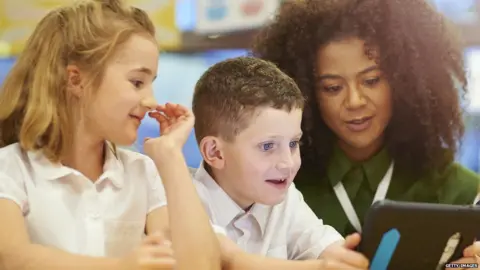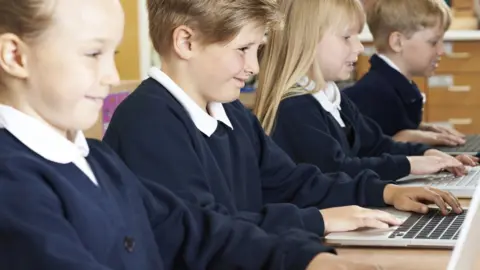Poorest pupils 'two years behind when they sit GCSEs'
 Getty Images
Getty ImagesThe very poorest children in England have fallen even further behind their non-disadvantaged classmates since 2007, research says.
The Education Policy Institute study suggests the most disadvantaged pupils are more than two years behind their classmates when they sit their GCSEs.
These children were those entitled to free school meals for 80% of their time at secondary school.
The Education Secretary has warned of a social mobility emergency.
And in a recent speech, Justine Greening highlighted some areas of the country with an "entrenched disadvantage" - where low skills and poor employment were found in a downward spiral alongside underachieving schools.
The EPI report, Closing the Gap? acknowledged the disadvantage gap had been entrenched in the education system for generations and that successive governments had tried to tackle it.
It analysed official data on GCSE, other test results and pupil background from the national pupil database and distinguished two groups of pupils whose results it compared with all other state school pupils.
As well as the most disadvantaged or persistently poor, researchers looked at disadvantaged pupils - those who have been on free school meals at some point.
And researchers converted academic results into months ahead and behind to make it easier to understand.
Slow pace
It found the attainment gap between persistently poor pupils and their non-disadvantaged peers had widened by 0.3 months to 24.3 months over the past decade.
However, the achievement gap between disadvantaged children and their classmates was found to be narrowing - but at a very slow rate.
The report said: "Despite significant investment and targeted intervention programmes, the gap between disadvantaged 16-year-old pupils and their peers has only narrowed by three months of learning between 2007 and 2016.
"In 2016, the gap nationally, at the end of secondary school, was still 19.3 months.
"In fact, disadvantaged pupils fall behind their more affluent peers by around two months each year over the course of secondary school."
It adds: "At current trends, we estimate that it would take around 50 years for the disadvantage gap to close completely by the time pupils take their GCSEs."

Analysis by Hannah Richardson
Children from the poorest backgrounds are often dogged by low expectations with the low aspirations their parents have for them and their own low hopes and poor levels of self-confidence.
Before these children even reach school they tend to be months behind their reception classmates.
They are less likely to have suitable books at home, to have space to do homework or learn to read and parents with time and tenacity to help them with it.
So as school progresses, the gap in achievement between them and more financially stable peers tends to widen.
While their wealthier friends gain confidence from dance, drama and sports classes, poorer pupils struggle to gain the vocabulary needed to express themselves in class.
It is hardly surprising that by the time they do their GCSEs, these children on average need an extra two years of study to get to the point academically that their more comfortably off peers have already reached.

 Getty Images
Getty ImagesThe disadvantage gap was generally smaller in London, southern England and eastern England (16 to 18 months), while in the East Midlands and the Humber, northern England and south-west England, the gap is significantly larger, at 22 months by the end of the GCSE year, the report found.
In the Isle of Wight, disadvantaged pupils were found to be well over two years (29 months) behind their peers by the end of secondary school.
Darlington, Derby, Luton, South Tyneside and Thurrock also performed poorly, despite successive attempts to address the issue.
It added: "The present government has acknowledged this burning problem and is seeking to address it, including through a focus on 'Opportunity Areas'.
"This could be a good start, but there are dozens of other areas up and down the country not covered by these areas where social mobility is stagnating or even worsening."
Researchers also acknowledged that 40% the achievement gap between the poorest pupils and others opens up before children even reach school and argued that this is where resources should be focused.
'Cash starved'
National Union of Teachers assistant general secretary Avis Gilmore said unless investment and the correct interventions are in place, the attainment gap between disadvantaged pupils and their peers would continue.
"Local authorities and schools are being starved of cash resulting in the closure of - or cutbacks to - many essential support services for those pupils most in need."
Chris Keates, general secretary of the NASUWT teachers' union, said factors common among pupils who are falling behind include child poverty, insecure housing, poor physical and mental health among families and job insecurity.
"These have all seen an increase as a result of the government's austerity programme and reforms to welfare."
The Department for Education said it is targeting almost £2.5bn this year through the Pupil Premium to help schools raise the attainment of disadvantaged pupils.
It also highlighted that it is running a £72m programme to create opportunities for young people in areas where disadvantaged people struggled to progress.
